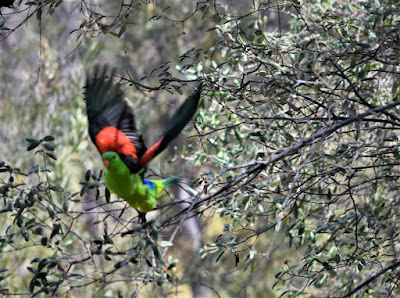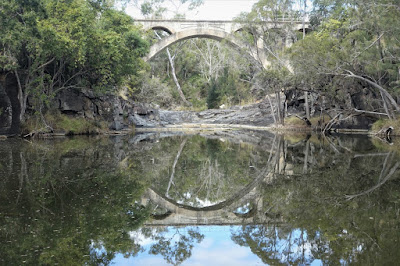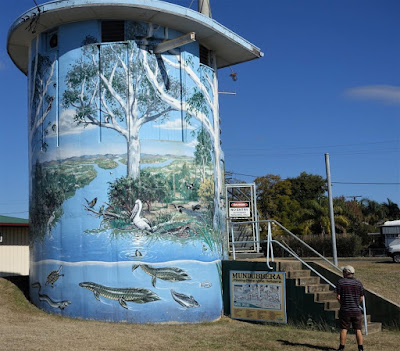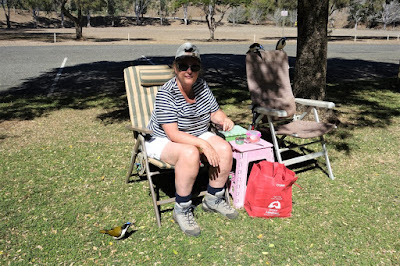Entry 15 – Queensland inner central lands. – 13/8/18 – 26/8/18
Leaving Cania Gorge National Park we propped about 34
kilometres down the road at Monto, restocking our fridge, pantry and fuel
supplies. Cania Gorge had been a phone free location and with Monto connected
to the electronic world, enabling us to catch up with all our internet and
phone requirements.
Our thoughts over the last month had been to continue
travelling north west, exploring inland Queensland regions. During the last few
days we had waned from thoughts of inland regions due to the consequences of
the current severe drought conditions leaving the country side looking lifeless
and unappealing. The weather for the last three weeks had been to our liking
with day time temperatures of about 24 C which was our primary reason for
travelling to this region of Australia. The ongoing discussion of various ideas
provided thoughts for heading back to the Hervey Bay regions and spending time at
the beach side location of Inskip Point near Rainbow Beach and surrounding
locations sounded the most appealing.
With the excitement of returning to an area we first
experienced in 2013 we sent a text to a lovely NSW couple we first met there
whom we had caught up with four times since at other locations in Australia.
Text; - “Where the bloody hell are you? We are heading to
Inskip Point! Meet you there?”
One minute later, Mary was in the process of typing up
another text to one of our special home neighbours notifying our plans when the
phone rang.
Answer; - “We are on our way to Emerald, (about 450
kilometres NW of our present location,) where we are going to spend a couple of
weeks red claw hunting. Come on up!”
Our immediate thoughts, we hadn’t partaken in this red claw
stuff.
Our response; - “See you tomorrow.”
Mary then proceeded to finish her text to our neighbour; -
“Sorry, change of plans. We are now heading to Emerald.”
We do “so” enjoy the versatility of our caravan lifestyle!
Assessing travel routes to Emerald we decided to travel
through an unexplored area for us, Dawson Hwy, Biloelia – Rolleston –
Springsure – Emerald. It wasn’t long before we encountered a steady flow of
mining vehicles. As it transpired along this route there were a number of coal
mines. Other than dealing with a steady flow of heavy vehicles in both
directions the bitumen road was in poor condition with the bitumen edges
looking like a badly corrugated dirt road with uneven peaks. It was one of the
more unnerving roads we have experienced, particularly when moving over to the
left of the road with oncoming vehicles. The uneven ridges were bouncing us back
towards the oncoming vehicles where we found ourselves braking to a near stop,
if no heavy vehicles were on our tail.
Several times we needed to negotiate animals searching for
feed along the road sides.
Mid-day the following day we arrived at Lake Maraboon about
20 kilometres out of Emerald, booking into the caravan park for a week. Our
other travelling colleagues were close by, within yelling distance. We spent
the rest of the day, late into the evening chattering away with Mick & Jen,
catching up with one another’s news.
The large-ish Lake Maraboon caravan park exists primarily
due to the presence of Red Claw in the lake with a high volume of caravaners carrying
boats mounted on their tow vehicle roof tops with disassembled boat trailers. Each morning boats travel out to
various locations around the lakes 274-kilometre shoreline to check traps for
red claw catches, resetting for inspection the next morning. Mornings we sat
outside eating breakfast watching the boats heading out.
Australian red-claw lobster, “freshwater crayfish”, are
native to northern Queensland and Northern Territory. Other locations it is
present, from being introduced the red-claw is deemed unwanted including Lake
Maraboon, thus there are no limits on the volume of catches other than in its
native regions. It seemed most people returned with a catch, with Mick &
Jen returning with regular catches of around 40 and a nearby neighbour with 90
from one nights set traps.
Lake Maraboon caravan park would have been one of the
happiest caravan park environments we had experienced. Happy hour was a great
friendly time.
We enjoyed watching a variety of birds flying about at camp.
In the back ground we regularly heard the sound of Brolga’s screeching. One day
Mick took Steve out on the lake to a far away shore where they viewed many
Pelicans and 100’s of Brolga’s further back above the heads of the Pelicans.
Another bonus staying at a location near a main town,
(Emerald,) for an extended period, enabled us to get our mail forwarded. We
have our mail forwarded to a post office, paying a little extra enabling us to
track our mails movement. On this occasion it was 3 months of mail, arriving
from Adelaide in 3 days. With our mail sorted it was time to resume to plan D
or H or thereabouts and we started to head SE towards the Hervey Bay regions. During
our travels, whenever the route suited we would choose a non-primary road to
travel along where we could slow down and enjoy the country side driving at a
more leisurely pace. This day away from the primary road, that more sedate pace
may have saved us from sustaining vehicle damage. From the time we saw one
kangaroo with intentions to jump out in front of us, hard braking including
some tyre squealing dropping our speed as quickly as possible from 83 kph down
to 23 kph one kangaroo disappeared under the driver’s side corner roo bar,
still hopping frantically away. Picture attached showing the position of
kangaroo and still travelling at a speed of 51 kph, under hard braking.
Complements of our dash cam.
Another hazard incurred on some back roads are narrow
bridges wide enough for only one vehicle at a time with no railing.
Two days later we arrived at our planned destination, Isla
Gorge. Our granddaughter is named Isla and Steve had spotted a green blob on the
map called Isla Gorge National Park, so Isla Gorge N.P. was a calling. What a
gem did Isla “two,” turn out to be. The views were breath taking with no photograph
able to show the dramatic scenery seen through our eyes.
 |
| View from caravan door |
Our first night at Isla Gorge we had a little picnic
watching the sun set.
Isla Gorge was part of the Dawson Range of Central
Queensland Sandstone Belt which includes our loved Carnarvon National Park.
Isla Gorge does not have any sanctioned walking trails due to the steep rugged terrain
quite different to the accessible Carnarvon N.P. There were a couple of short well-worn
walking tracks, along the ridges with steep drop offs we delighted in walking
with picturesque views.
 |
| Steve walking along the ridge track |
After leaving Isla Gorge we spent three days driving, with
plenty of breaks exploring some of the offerings along our route. About 400
kilometres down the road we arrived at our next planned destination of Inskip
Point near Rainbow Beach overlooking the southern point of Fraser Island. The
weather forecast for the next week looked promising with predicted daily
temperatures in the mid 20’s with one day of possible rain.
























































































